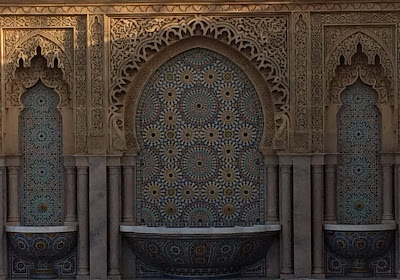Fun fact: Morocco was the first country to recognize US independence. According to the Moroccan Embassy’s web site, the US used the port of Tangiers so often during the American Revolution that the Continental Congress sought to formally recognize the close relationship in 1777. A treaty, the Moroccan-American Treaty of Friendship, was signed in 1786 and is the longest unbroken treaty in US history.
While you were playing in 2 feet of snow, I was standing in the sun outside of the heavily fortified US Embassy building, waiting in line to empty my pockets and walk back-and-forth through the metal detector until even the lint in my pockets ended up in the little basket of prohibited items. The embassy personnel, with extensive experience in education in Morocco - and throughout Africa - helped our group understand the current state of Moroccan education. It’s a pretty interesting story that I’ll save for later.
A mid-afternoon lecture on Morocco’s history and culture bought the group a few hours of freedom, which we used to explore the Hassan Mosque and Tower as well as the Mausoleum of Mohammed V.
Construction of the Hassan Mosque (below) began in 1195 and would have been the second largest mosque in the world during that time. In 1199, building was halted and today visitors can only see the ruins of the walls and the minaret.
Construction of the Hassan Mosque (below) began in 1195 and would have been the second largest mosque in the world during that time. In 1199, building was halted and today visitors can only see the ruins of the walls and the minaret.
Adjacent to the ruins of the mosque is the Mausoleum of Mohammed V (below). In fact, it’s not just Mohammed V, but also Hassan II (Mohammed’s son) and Moulay Abdellah (Hassan’s brother) who are entombed in the mausoleum. The structure is covered in stunning mosaics, ornate carvings, and phrases in Arabic.
 As we were preparing to leave, the call to prayer (the 4th prayer of the day) began. The door behind me opened and Muslim men began streaming through the gates around the Hassan Mosque and entering the working mosque behind me.
As we were preparing to leave, the call to prayer (the 4th prayer of the day) began. The door behind me opened and Muslim men began streaming through the gates around the Hassan Mosque and entering the working mosque behind me.
